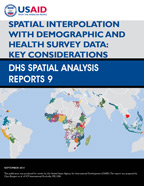- PUBLICATIONS
- JOURNAL ARTICLES
- ACCESS PUBLICATIONS
Publications Summary
- Document Type
- Spatial Analysis Reports
- Publication Topic(s)
- Geographic Information
- Language
- English
- Recommended Citation
- Burgert, Clara R. 2014. Spatial Interpolation with Demographic and Health Survey Data: Key Considerations. DHS Spatial Analysis Reports No. 9. Rockville, Maryland, USA: ICF International.
- Download Citation
- RIS format / Text format / Endnote format
- Publication Date
- September 2014
- Publication ID
- SAR9
Download
 Spatial Interpolation with Demographic and Health Survey Data: Key Considerations (PDF, 2498K)
Spatial Interpolation with Demographic and Health Survey Data: Key Considerations (PDF, 2498K)
